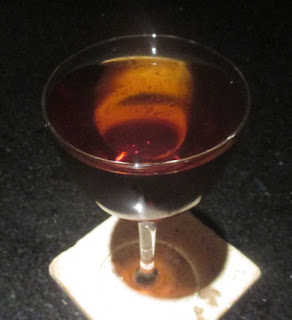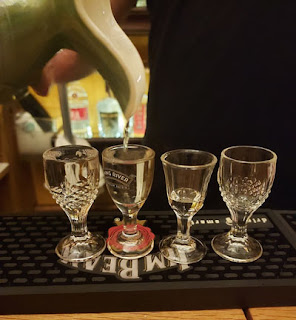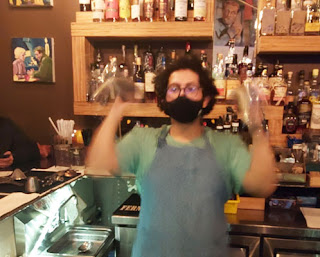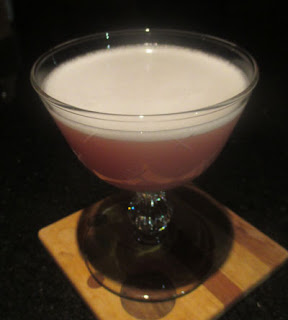In 2010, I was asked what my favorite cocktail that year was, and I decided not only to start a list of my favorite drinks, but I decided to list the top moments of the previous 12 months. So to continue with the tradition (despite 2021 being what it was), here is the 12th annual installment:
1. Finished up two years as a Whiskey Guardian for Angel's Envy.
Last
year, I described how I became a Whiskey Guardian in late 2019, and how I could finally talk about it. 2021 saw the virtual events and videos with liquor stores convert into more in-person activities after I got my second vaccination shot. Some of those virtual events were a series of 30
videos whiskey cocktails created around Boston as well as 2 shot for Black History Month. Another favorite was a cocktail
video that I filmed for the Ellie Fund charity (who I donated to at my 2020 post-Speed Rack afterparty) to promote their gala, and thus I was wearing a shiny smoking jacket and actually put on a tie for demonstrating how to make their signature drink that I crafted. Also done virtually were three Bourbon Book Clubs and one Bourbon-Taza Chocolate pairing that were big hits with the bartenders who participated (especially the chocolate one comparing the similar fermentation and toasting processes that go into chocolate and into the Bourbon/barrels to generate overlapping molecules, and how the different chocolates shifted the flavor of the spirit). After I started going out more at the end of April, my two favorite activations were before and after Toast the Trees in September. The first was a cigar afternoon at Stanza di Sigara for the bartenders with Toast the Tree drinks on their menus, and the second was dubbed Toast the Historic Trees of Boston: A Walking Tour that involved revolution, pirates, and more. Also, a photo of the cocktail class at Andy Husbands' The Secrets of Fried Chicken is down below. Alas, after my boss departed the Northeast region at the end of August and leadership became nebulous for a few month, it became time to leave.
2. Helped to re-open Drink.
After I got my second shot, I began working at the Smoke Shop BBQ in Somerville, MA, part-time to complement my Whiskey Guardian work. A combination of having the largest collection of American whiskeys in New England, knowing the GM through my brand work and through the USBG, and having it be walking distance from home (back when Lyfts and Ubers were scarce) made for a solid choice. After my Whiskey Guardian position was wrapping up, I realized that I needed something more. When I saw the ad for Drink's re-opening, I applied. Drink had closed for 4 1/2 months to fix up their leaking foundation that shut them down sporadically for over a decade every time it rained hard, and they figured that it was better to do it right than deal with it multiple times a year. Unfortunately, the staff at the beginning of July all moved on to other jobs which broke up the continuity of the training program that had been going since late 2008. In mid-November, we were led by Drink alum Will Thompson to start the program back up, and now we are towards the end of our 7th week open doing 4 nights per week. This has been a great experience making a wide variety of cocktail recipes with my estimates being somewhere between 100-150 drinks in the 8 hours that we are serving. Everything from Maloney's 1900
Manhattan Bell-Ringer to Phil Ward's
Lipspin has come up in my dealer's choice. It has been a great learning experience especially as guests push my knowledge limits (like when there is a request for a
Charlie Chaplin or they want a drink that tastes like cotton candy), and a great teaching experience as I help to guide the more junior staff. The latter part of that may blossom into something more in 2022. It has also been very rewarding; one example is how we had two deaf guests the first week, and I spent a bit of time describing the drinks that they got and answering their questions by way of a few dozen Post-it notes. That patience paid off as they returned a few times including one of them taking his party of 9 (all deaf) for his birthday a week or two ago. I think that they won in the communication front because they could sign to each other at a distance over the music levels. Below photo taken by Ran Duan on opening night:
 3. Did some writing.
3. Did some writing.
Besides keeping up with the blog for a little over a post per day, my writing for the
Oxford Companion to Cocktais & Spirits finally came to fruition as this tome containing two of my articles finally came out in early November. In addition, I wrote an
article for the USBG National site (and republished on my blog) about how to deal with the drown during service in response to a question on
Reddit. I also wrote up my notes from attending the
Boston Baijiu Bar and a sherry class. Hopefully, I will be more motivated to write essays due to working in a thought-stimulating bar environment and as I attend more in-person events if conditions allow for that. 2021 only had me leaving the Boston area once for an Angel's Envy regional meeting, and that gamble showed how risky meeting up in person can be (yes, I was on the wrong end of a super-spreader event).
4. Got some press.
With less going out, I spent more time replying to reporters' questions. For big issues, I was quoted in a
Total Food article on how supply chain problems are affecting the beverage industry as well as in a
Boston Globe feature on the risks and confusion of bars and restaurants entering the second pandemic Winter. I spent a glorious hour on the phone being interviewed by Hawthorne/Eastern Standard alum Jackson Cannon in regard to Misty Kalkofen's years before and after the Green Street-Drink move for a
piece on the Bohemian for
Boston.com. The other 15 were my recommendations for lists.
Liquor.com quoted me on my favorite
white rum,
wheat beer,
aperitif wine, and
beer book (even if they fudged my suggestion of Garrett Oliver's
Brewer's Table and replaced it with his
Oxford Companion).
Bar Business took my interest in boilermaker pairings to heart in their
list in honor of International Beer Day. Finally,
Uproxx cited my picks for best
value Bourbon,
strong ale,
Irish beer for St. Patrick's Day,
beer for Spring,
wheat beer and
IPA for Summer,
award winning whiskey,
single malt for Fall, and
Oktoberfest beer.
 5. Still involved in the Boston chapter of the bartenders guild.
5. Still involved in the Boston chapter of the bartenders guild.
2021 marked the 3rd year of my term as USBG Boston Secretary, and I just got re-elected for another 3 year term. Early in the year, I organized a series of "Classic Cocktail Virtual Happy Hour"s that featured a cocktail theme as an excuse to teach a bit of history and drink lore as well as virtually congregate and chat. Our spirits education started virtually and ended with some real visits: two of the virtual ones included a Seedlip mixology class and a Teeling Irish Whiskey virtual tour (amazing software!) and cocktail class. In person, we visited Short Path and Boston Harbor Distilleries for tours and tastings, and also had the brand ambassador for 818 Tequila come to talk with us. Also in person, we did our 5th annual kayak adventure on the Charles River, the Campari Day of Service packing up and distributing food at the East End House in Cambridge, MA, and held USBG Education Week classes on Coffee 101 and Scotch & oyster pairings. Some of the 2021 programming that we had lined up got delayed due to health concerns and will hopefully come about in 2022.
6. Read a bit but not as much as last year.
I was off to a good start with my reading, but as the world opened up to me after my second vaccination shot, my brand work plus bartending had me too distracted to focus. I read trio of great books for Camper English's book clubs, namely Chantal Martineau's
How the Gringos Stole Tequila, Tristan Dononvan's
Fizz: How Soda Shook Up the World, and Robin Wall Kimmerer's
Braiding Sweetgrass: Indigenous Wisdom, Scientific Knowledge and the Teachings of Plants. I (re)read a trio of whiskey books for my Angel's Envy Bourbon Book Club that included ones from Bernie Lubber, Dane Huckelbridge, and Reid Mitenbuler, and I added to my knowledge by jumping brands with David Jenning's
American Spirit: Wild Turkey Bourbon from Ripy to Russell. Another favorite from the remaining books that I read came as a recommendation from one of the Bourbon books for my book club was
Stork Club: America's Most Famous Nightspot and the Lost World of Café Society by Ralph Blumenthal. Hopefully, I can regain my pace of two books per month in 2022!
7. Created drinks!
I posted around 44 of my
new creations here on the blog. Some of my favorites include a duo inspired by a new batch of raspberry syrup, namely a mashup of a Negroni and Clover Club called the
Negroni Club and a Pink Lady-Martini combination dubbed the
Gypsy Rose. A duo of Cubist/Dada themed ones were the
Nude Descending a Staircase that was inspired by a recipe I acquired from a visit to Amor y Amargo in August and
A Prelude to a Broken Arm as a embittered Sidecar riff. T. Cole Newton's
Cocktail Dive Bar inspired New Orleans-style creations such as the
Tin City Sazerac. And finally, Jackson Cannon's Heather in Queue plus his 2014 "Letter to a Young Bartender" led to my
Letter to a Younger Self Scotch-applejack drink.
 8. Visited brewery taprooms.
8. Visited brewery taprooms.
Pre-vaccination days and the cold weather put a crimp in the first third of 2021, but I was able to visit 45 breweries this year. Of those, the following were new to me: Tributary, Definitive Brewing Co., Trillium (their new spot in Canton), True West, Odd Fellows, Lithermans, Progression, Fort Hill Brewery, Woodland Farms, Odd by Nature, and Hopothecary Ales. Of the return trips, I noticed on my
Untappd account that there were more than one visit to Oak & Iron, Remnant, Brewery Sylvaticus, Castle Island, Faces Brewing Co., Winter Hill, and True North. And plenty of hops were appreciated on our second floor deck or at my kitchen counter here at home.
9. Increased my bartender-author cat herd.
2021 was a sad year when we lost Budgie, our Maine Coon cat of 18 years who passed on at age 19. Embury (named after
David Embury) became rather lonely, so in late October, we adopted a young feral cat who we named Boothby after the San Francisco
bartender-author. Embury taught Boothby the ways of indoor life and living with humans, and Boothby has become a delightful work in progress as he just turned one last week (an approximate aged based off his trapping date). We may add a third in 2022 to balance out the age and energy levels of our new recruit, but it is to be determine if we keep with this new naming convention.
 10. The tenth entry always causes me pause.
10. The tenth entry always causes me pause.
This pandemic has continued to disrupt the continuity of life as things looking better before looking worse. Wearing a mask for 14 hour stretches from getting on the subway to getting out of my Lyft at the end of the night is not a big deal, especially compared to the realization that one of these new strains will get me sick again due to my chosen profession. It has certainly put a crimp in my travel with the effects of my one trip to New York City preventing me from my second one to attend and work an event at the Bar Convent Brooklyn due to my positive lab result. Hopefully, as things improve, either the USBG or my new job at Drink will afford me some travel opportunities or at least local adventures in the future. Luckily, guests at work have been rather understanding as we go either understaffed or without a food menu due to various situations. The show goes on, and with that, I bid you adieu from my year-end wrap up (besides tomorrow's best drinks edition) until 2022. Cheers!



















































 The 2017 collection of 855 drink recipes, bartender tributes, and essays on hospitality from CocktailVirgin's Frederic Yarm. Available at Barnes and Noble and Amazon.
The 2017 collection of 855 drink recipes, bartender tributes, and essays on hospitality from CocktailVirgin's Frederic Yarm. Available at Barnes and Noble and Amazon. The 2012 collection of 505 drink recipes, techniques, and Boston bar recommendations from Frederic Yarm. Available at Amazon and Barnes and Noble.
The 2012 collection of 505 drink recipes, techniques, and Boston bar recommendations from Frederic Yarm. Available at Amazon and Barnes and Noble.